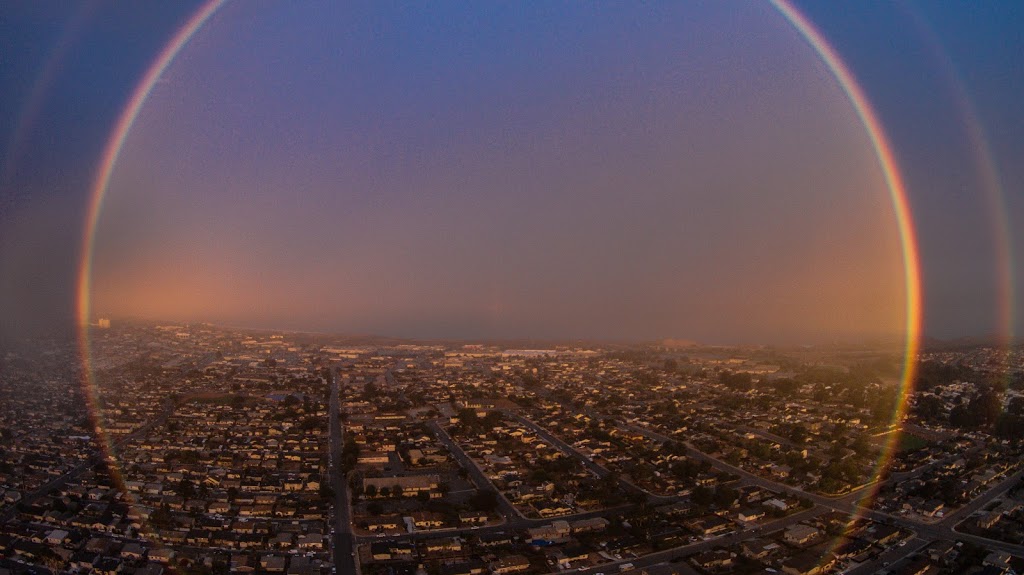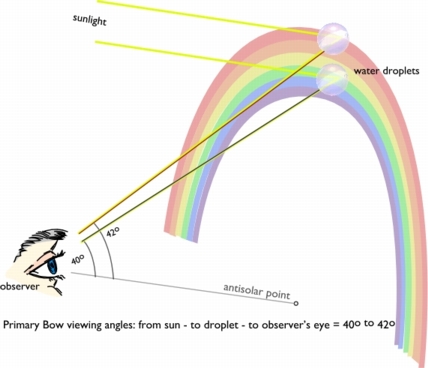
 |
|
|
A new perspective can show us things we never knew existed. . . and it can change how we think of even common things like rainbows
From my Facebook, Google+ and Twitter post:
“Double Rainbow Over The Monterey Bay this morning!!!
This happened at dawn just before the rain started falling. I took 3 perspectives of this double refractive beauty to see if I could show you something special about rainbows that you probably did not realize. You will see that perspective is everything to how things look in our mind.”
You have learned since childhood what the shape of a rainbow is… and You Were Brainwashed !!!
The main things we were taught about rainbows as kids was that what we see is the same thing that a prism does. Which is not the whole truth. Rainbows are caused by water droplets which are not prisms but have prismatic qualities. The science teacher always showed us a prism that split light into the different frequencies we see as color just like a rainbow does. The problem is that rainbows are based on spherical water droplets with a “prismatic” bending effect rather than a light straightening triangular prism which directs light differently. Most importantly they never told us that rainbows are not “rainbow shaped”.
The best explanation I could find about rainbows states that they are actually shaped like cones and that there are almost always double rainbows if you look hard enough:
From the URL http://mysite.du.edu/~jcalvert/astro/bow.htm
The variables influencing the rainbow are the altitude of the sun, and the size of the raindrops in which the rainbow is seen. The rainbow is a cone making an angle of 42° with the antisolar direction, which is normally beneath the horizon for an observer on the surface. When the sun is at an elevation of 42°, only a little arc at the top is visible at the horizon. As the sun sinks, the arc of the rainbow rises in the sky, until at sunset it forms a semicircle. The eye interprets the light arriving on the cone as a circle somewhere in space, though the rainbow is really only a direction. If the observer is at a slight elevation, some of the rainbow can be seen beneath the horizon, in front of not too distant objects, which gives the impression of a physical existence not too far away. The story of the “pot of gold” at the end of the rainbow takes advantage of this illusion to send fools on a quest. The rainbow just keeps receding as they try to approach it. We should realize that the rainbow is a cooperative effect of many raindrops, with considerable depth, and that our visual impression is the best the visual sense can do with its data. When you see a rainbow, try to estimate its apparent distance from you, or its apparent size.
Let me show you what a rainbow really looks like. The following three perspectives demonstrate the science behind this basic optical effect. Here are the images followed by my explanation of what you are seeing and where it was taken from.
 |
| Image No.1 | Ground Level | Nikon D800E | by George Krieger We are only seeing 1/2 of a rainbow or less from ground level!!! |
Image No.1: (Ground Level) To us a rainbow is a 1/2 spherical arc generated by sunlight refracting through water droplets in the air. We see this only because our visual perspective is too close to the earth. If we go further up we can see more. Here we are limited visually to the true magnitude of this phenomena.
 |
| Image No.1 | 200 ft Altitude | DJI Vision+ | by George Krieger |
Image No.2: (200 ft Elevation) Here is a clue as to what a rainbow really looks like. Look at the shape it is clearly more of a circle than in image No.1 and the only thing that has changed is the elevation of your perspective and the drone was flying about 20 feet away from the original picture to the left. But we are still too close to earth to see what is really happening when we get a rainbow.
 |
| Image No.1 | 390 ft Altitude | DJI Vision+ | by George Krieger |
Image No.3: (390 ft elevation) Now we are just high enough to see what I wanted to show you. Here you can plainly see that a rainbow is indeed a more circular shape (actually it is a conical projection made when light passes through a mass of spherical shapes and refracts its light in a common direction). It is sort of like a large bubble where you can see the optical effects around the edges but not in the middle.
Again the only thing that is different here is elevation and your perspective. This is what the light bending event we call a rainbow really looks like. If we were higher up (and still at a viewable angle) we would see the rainbow as a complete circle looking just like lens flare (they both work on the same principle of optics called refraction).
Here is the Video I shot while landing to visually explain the phenomena..
The next time you see a half of a rainbow you are gonna feel cheated unless you have a drone or a way to get some elevation in the right place to see the whole thing, sorry about that.
Imagery and write up by George Krieger george@xarray.com
Cameras used at each position:
Ground level image taken with a Nikon D800E (and really bad settings)
Aerial Images taken with the DJI Global Vision+ Flying Camera (Drone)
Location Our back deck in Seaside, California..
